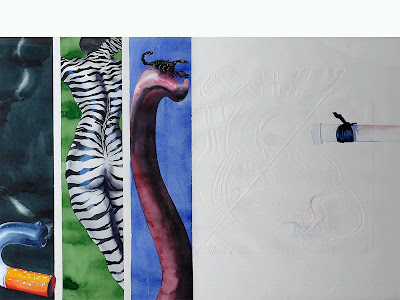This week I would like to talk about my meeting with artist Badri Narayan and his forthcoming exhibition. After living in Mumbai for several years, the artist shifted to Bangalore a couple of years ago and although he has been suffering from ill health he continues to paint. His zest for life and his spirit remains indomitable and in fact the several paintings that graced his walls, have been painted by him in the last couple of years.
Born in 1929 in Secunderabad, Badri Narayan is a self-taught artist and has been painting for about six decades. He has worked with several mediums such as paintings, ceramics, tiles, woodcuts and engravings. He was honoured with the Padma Shri in the year 1987.

A master storyteller, Badri Narayan weaves tales that are inspired by Indian myth and folklore - the Jatakas, Puranas and other stories. But, the interpretation of these is completely unique and centres round everyday life.
From an early age he was interested in literature, folk tales and visual arts and probably that explains a strong influence of these elements in his repertoire. Compassion, wisdom, kindness are just some of the emotional foci that form an integral part of his narrative. The characters in his visuals may belong to another age and period but the events and episodes portrayed are contemporary in narration and relevance. Relationships and other human traits fascinate the artist and are brought out through detailed depictions. As Badri Narayan’s art draws heavily from the folk arts, the images are stylised and may even appear child-like at the first instance. But there is a rich simplicity that evokes an instant emotional connect. In his colourful watercolour paintings too there is a strong use of the pen and ink with motifs that are repeated for an ornamental purpose. He acknowledges the fact and is happy to promote and present Indian cultural and traditional elements through his art. For instance, there is extensive cross-hatching (tiny criss-crossed lines) done in some of his works. Symbols and metaphors are also often used to emphasize the significance. Despite their illustrative quality the paintings and drawings are fluid and eloquent in their narration. In his new series, a number of drawings are inspired by Hamsa - the mythical swan. The drawings are sparse yet compelling as they spin a new tale.

Badri Narayan’s series of pen and ink drawings titled Hamsa, Jataka and Other Drawings will be showcased at Renaissance Gallerie from June 12 to 18.
(Published in Bangalore Mirror)
 Rawfacts - June 2008 Issue
Rawfacts - June 2008 Issue



